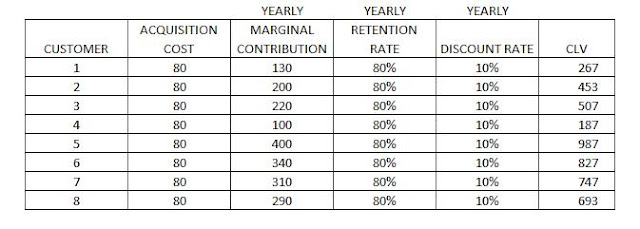OBJECTIVE
Estimate the lifetime
value of a customer or group of customers.
DESCRIPTION
Customer lifetime value is an indicator that
represents the net present value of a customer based on the estimated future revenues
and costs. The main components of this calculation are:
- - Average purchase margin (revenue – costs);
- - Frequency of purchase;
- - Marketing costs;
- - Discount rate or cost of capital.
There are several ways
to calculate it, and different formulas have been proposed. The most difficult
part is to estimate customers’ retention (in contractual settings) or
repetition and to estimate the monetary amount that a customer will spend in
the future. It is important to remember that CLV is about the future and not
the past, which is why using past data of a customer is not the best method for
calculating CLV. A good practice is to segment customers and estimate the
retention and spending patterns based on similar customers. Then, the following
formula can be applied:
- CLV = customer lifetime value
- MC = yearly marginal contribution, that is to say the total purchase revenue in a year minus the unit costs of production and marketing
- R = retention rate (yearly)
- D = discount rate
- CA = cost of acquisition (one-time cost spent by the company to reach a new customer)
Customer Lifetime Value of Different Customers
The discount rate can
be the average cost of capital for the company or the related industry, and it
is used to depreciate the value of future benefits to estimate what they are worth
today. With this formula we
can estimate the CLV of a single customer or a segment of customers. In the
case of estimating it at the individual level, we should use the retention rate
(r) of similar customers, for example customers who buy similar products, or more
sophisticated techniques, for example cluster analysis.
When we define the
value of a customer or a group of customers, we can make decisions concerning
the level of attention, the investment in marketing and retention costs, or the
amount that we can spend (cost of acquisition) to attract customers with a
similar CLV.
Even though it is
quite difficult to estimate, we have to consider that the CLV formula does not take
into account the value generated by referrals. Although some formulas have been
proposed,[1]
this calculation is seldom used due to the lack of information. In fact, to
calculate the customer referral value, we need information about the advocates
and the referred customers, and for the latter we should be able to distinguish
those who would have made the purchase anyway (without the referral). As a
proxy we can use the NPS (see 29.
NET PROMOTER SCORE® (NPS®)) combined with other information from surveys,
such as asking whether a customer has been referred and how much the referral has
affected the purchase.
The market’s historical
data is the main source of information (at the individual level, usually from
CRM systems), but it can be enriched with survey data, for example concerning the
likelihood of repeating the purchase or recommending the product.
TEMPLATE


No comments:
Post a Comment